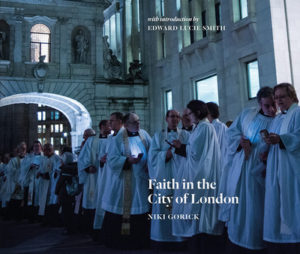 A while ago, during one of our communion services at St Bride’s, Fleet Street, Alison Joyce, the rector, told the congregation about a forthcoming book about faith in the City of London expressed through photographs. The images would reveal the many different ways spiritual life is celebrated in the City and embraces contemporary culture. The book would show how the area is not just a hive of business and finance. Places of worship in the City are not simply historic, architectural specimens, incongruent with the area’s landscape and cut-throat business. Indeed, our church, would be featured, Alison beamed.
A while ago, during one of our communion services at St Bride’s, Fleet Street, Alison Joyce, the rector, told the congregation about a forthcoming book about faith in the City of London expressed through photographs. The images would reveal the many different ways spiritual life is celebrated in the City and embraces contemporary culture. The book would show how the area is not just a hive of business and finance. Places of worship in the City are not simply historic, architectural specimens, incongruent with the area’s landscape and cut-throat business. Indeed, our church, would be featured, Alison beamed.
Niki Gorick, the author, was seeking funding for self-publication, the rector explained. Maybe a few of us might wish to help crowdfund the project? Gorick, she added, was a well-established fine art photographer, whose work focuses on capturing the character of London life.
Our copy arrived during lockdown, a time when we were missing the camaraderie of our congregational members, many with whom we had formed quite deep friendships. We were listening to online services, creatively put together by parishioners with readings and intercessions recorded by members; but this was peculiarly both alienating and unifying, ultimately deeply unsatisfying. Praying together as one body in one space is part of the nucleus of our faith. Reading a pictorial book about faith, one recommended by our priest, was another, albeit not perfect, means of forging some sort of spiritual link with our fellow church members during a dystopian period in our lives.
I found the photographs in Gorick’s book especially illuminating because of the unexpected and surprising endeavours they present. They prove how religion in the Square Mile is very much interwoven with contemporary culture and social change. The well-articulated captions accompanying the images are refreshingly free from jargon and convoluted phrasing.
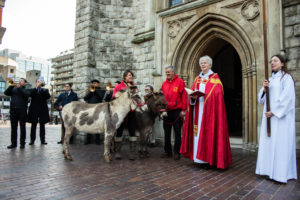 Images reveal female clergy who occupy influential positions within the Church of England in the Square Mile and beyond, unlike even just decades ago. We see Katherine Hedderly, Area Dean to the City and chair of the Deanery Synod who has an untraditional clergy background, having been a graduate of the National Film and Television School and producer and director of an independent television company. In quite a few images appears the first female Bishop of London, Sarah Mullaly. Featured also is the first female incumbent of a church in the City, Katharine Rumens, now the rector of St Giles’ Cripplegate in the Barbican. She used to be an art teacher and fashion designer before ordination. Our own Alison Joyce, who has a high profile in the national press, is pictured.
Images reveal female clergy who occupy influential positions within the Church of England in the Square Mile and beyond, unlike even just decades ago. We see Katherine Hedderly, Area Dean to the City and chair of the Deanery Synod who has an untraditional clergy background, having been a graduate of the National Film and Television School and producer and director of an independent television company. In quite a few images appears the first female Bishop of London, Sarah Mullaly. Featured also is the first female incumbent of a church in the City, Katharine Rumens, now the rector of St Giles’ Cripplegate in the Barbican. She used to be an art teacher and fashion designer before ordination. Our own Alison Joyce, who has a high profile in the national press, is pictured.
Some of the pictures show historical connections with a contemporary twist. In one photograph we see a mouth-watering – if you like fish! – display of fish by the Billingsgate merchants at St Mary-at-Hill during a harvest festival service. In another image, called “Building on Tradition”, 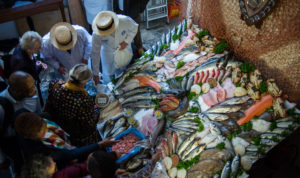 we see the installation of the new Master of a modern livery company of construction workers which only received its royal charter in 2010. One particularly amusing picture shows City and livery representatives and students from the once local St Dunstan’s College standing in a motorboat while trying to engage in some creative waterborne marking. They are reaffirming the boundaries of All Hallows by the Tower in accordance with an annual medieval tradition. We see members of the St Giles’ congregation leading two donkeys through the streets on Palm Sunday. The donkeys are also welcomed inside the church during the Palm Sunday service.
we see the installation of the new Master of a modern livery company of construction workers which only received its royal charter in 2010. One particularly amusing picture shows City and livery representatives and students from the once local St Dunstan’s College standing in a motorboat while trying to engage in some creative waterborne marking. They are reaffirming the boundaries of All Hallows by the Tower in accordance with an annual medieval tradition. We see members of the St Giles’ congregation leading two donkeys through the streets on Palm Sunday. The donkeys are also welcomed inside the church during the Palm Sunday service.
While St Bride’s has a tradition of promoting, as part of its ministry, individuals and organisations associated with the communications industry, its commitment and realization are very much linked to currents events. There is an altar in the church devoted to people who have worked in the media, journalists especially. Small Perspex frames hold pictures of the mourned, such as that of Jamal Khashoggi. Memorial services are often very much tied to tragic current events, such as that for Marie Colvin, the British American foreign correspondent killed in battle in Syria. Over a year ago, St Bride’s held a vigil for Lyra McKee, the promising young Northern Irish journalist who was murdered in Belfast.
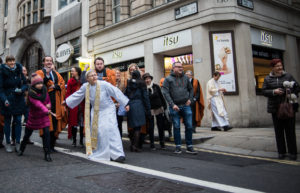 Images confirm that regular services with families in attendance are happening in the City. In the picture “Circle of Light” we see children in a circle waiting for their candles to be lit at a Resurrection Service on Easter morning at the Dutch Church in Austin Friars, which was founded by Protestant refugees from the Netherlands in 1550. Children from the Sunday School at St Bride’s enjoy the Easter tradition of egg rolling down Fleet Street at dawn. Who can roll the furthest, buses and taxis permitting?
Images confirm that regular services with families in attendance are happening in the City. In the picture “Circle of Light” we see children in a circle waiting for their candles to be lit at a Resurrection Service on Easter morning at the Dutch Church in Austin Friars, which was founded by Protestant refugees from the Netherlands in 1550. Children from the Sunday School at St Bride’s enjoy the Easter tradition of egg rolling down Fleet Street at dawn. Who can roll the furthest, buses and taxis permitting?
As St Andrew by the Wardrobe is closed on a Sunday, the Indian Orthodox community holds their three family services there. An image reveals the 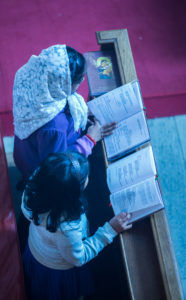 shiny black haired heads of a mother and her young daughter reading their prayer books. We see the beautiful Bevis Marks, the only synagogue in Europe that has held regular services for over 300 years, celebrating a family wedding. The synagogue holds a rich programme of faith based events and services for students and people working in the City.
shiny black haired heads of a mother and her young daughter reading their prayer books. We see the beautiful Bevis Marks, the only synagogue in Europe that has held regular services for over 300 years, celebrating a family wedding. The synagogue holds a rich programme of faith based events and services for students and people working in the City.
Indeed, there are other non-Christian services regularly held in the City. As there is no gurdwara temple in the City, the Sikh business community celebrates weekday prayer within the Bedouin Tent which in set in a courtyard at St Ethelburga’s Centre for Reconciliation and Peace.
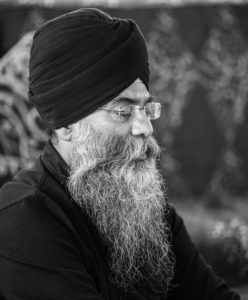
A moving black and white portrait reveals the grey bearded Mandip Singh leading the lunch hour prayer and discussions in the tent. Muslim Friday prayers are held in the livery hall of the Worshipful Company of Wax Chandlers.
Visual arts are also a feature in the City. Gorick presents a very atmospheric picture of what lies several meters below the European headquarters of Bloomberg: the remains of The Temple of Mithras, a site of pagan worship in Roman London for almost 200 years. (I recall , when visiting, the sound effects which help to bring the viewing experience alive; and this is quite eerie!)
Music flourishes. We see children from the Sir John Cass Schools preparing to play their violins at a Foundation Day service at St Botolph without Aldgate. Another photograph shows the 30 strong English Chamber Choir rehearsing for a performance at St Andrew by the Wardrobe . A colourful image, thanks to imaginative lighting, depicts an evening of Afghan music with some impromptu dance at St Ethelburga’s. There are many recitals in the City churches with contemporary instruments – such as those with jazz bands – and sometimes digital displays of scripture. Indeed, if one looks at the newsletter of Friends of the City Churches’ City Events, published monthly, one finds listings for an overwhelming wealth of recitals, concerts and lectures. One could be serenaded and educated almost every day the year.
The performing arts are not strangers to the City. One may enjoy Shakespearean plays in the surroundings of quite a few churches. Gorick shows a one hour performance at St Mary Abchurch of A Christmas Carol being enacted with actor Martin Prest who plays twenty characters. Another image reveals an interactive drama project taking place for children at All Hallows by the Tower. I recall seeing A Midsummer Night’s Dream at St Giles, and The Tempest at St Bartholomew the Great.
The pictures themselves are not stylised, or meant to be competition for the ‘Photographer of the Year’. Their value lies in making one understand what an enlightening force religion can be in the context of a seemingly cold environment infused with wealth. I would have appreciated the inclusion of an index noting the faith establishments featured, enterprising endeavours and personalities.
The pictures whets one’s appetite to know more about faith in the City. I was moved to learn more about St Ethelburga’s, intrigued by the Bedouin Tent. The Centre was built on the site of St Ethelburga’s church which was nearly all destroyed by an IRA bomb in 1993. The Centre engages in projects promoting social understanding and tolerance and concern for our environment. St Ethelburga was the first leader of a monastic order for women in England in the late first century. One of the chaplains at the Centre is Dave Tomlinson who founded a church in a pub in Clapham for disaffected church drop outs, and the author of How to be a bad Christian.  The picture of City of London Pastors compelled me to visit their site. The charity’s volunteers walk the streets of the City at night offering practical and spiritual support to members of the public.
The picture of City of London Pastors compelled me to visit their site. The charity’s volunteers walk the streets of the City at night offering practical and spiritual support to members of the public.
My husband and I would very much like to walk around the City, venture inside the places of worship and attend some of the services. For now, during lockdown, we content ourselves with private prayer and the pictures in the book.
Notes:
Images from top to bottom: Palm Sunday at St Giles’ Cripplegate with the rector, Katherine Rumens; a display of fish by the Billingsgate merchants at St Mary at Hill; the rector of St Bride’s, Alison Joyce, leading the egg rolling contest on Easter morning; at an Indian Orthodox service at St Andrew by the Wardrobe; Mandip Singh leading the lunch hour prayer for Sikhs in the Bedouin Tent at St. Ethelburga’s Centre for Reconciliation and Peace; a City Pastor in conversation with a member of the public. All images courtesy of Niki Gorick, (C) Niki Gorick.
Please visit https://www.unicornpublishing.org/page/detail/Faith-in-the-City-of-London/?k=9781912690732 for reference to Faith in the City of London, by Niki Gorick, Unicorn, 2020.
